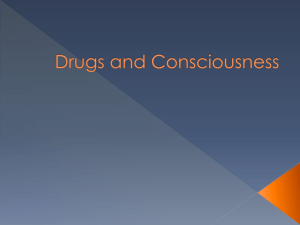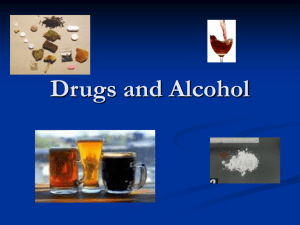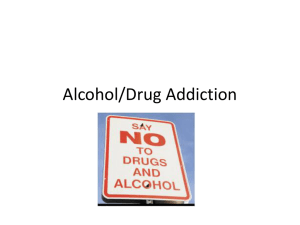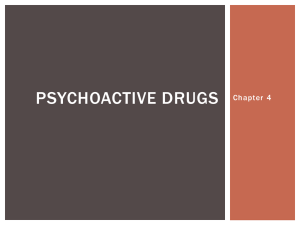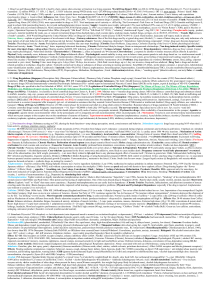Unit 15: Drugs
advertisement
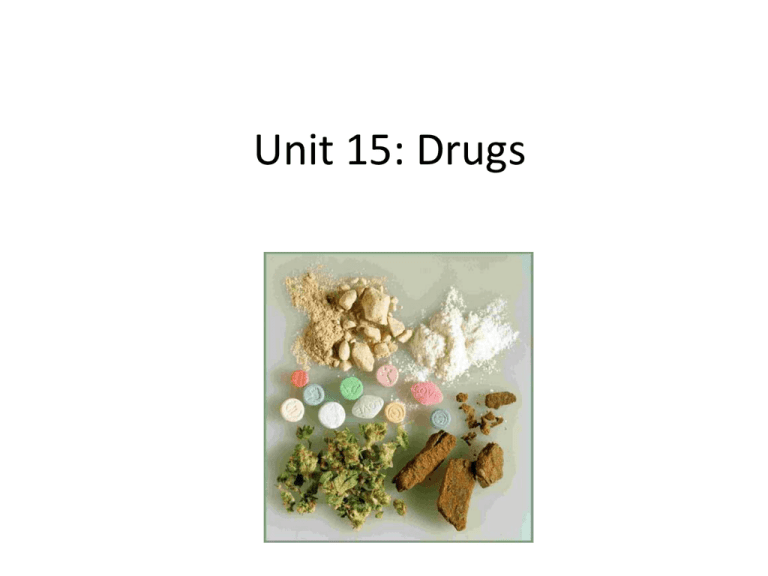
Unit 15: Drugs Overview • Drug= “any substance other than food or water that is taken in order to change the structure or function of the body” – Ex. Caffeine, Tylenol, alcohol • Psychoactive drugs = influence the brain chemistry so as to cause a change in perception, mood, thinking and/or behaviour – Ex. Cocaine, marijuana – In order for any drug that affects the brain to work it must cross the “blood-brain barrier” Routes of Administration • Injecting/smoking drugs: reaches the brain more quickly/ effects wear off more quickly, higher chance for dependence • Injecting drugs: possibility for infection • Smoking drugs: can damage your lungs • Oral pills: it takes longer to feel the effects because they have to travel down to your intestines first before they are absorbed COMMON PSYCHOACTIVE DRUGS Caffeine **most widely used drug in North America Coffee, espresso, tea, cola, caffeine pills, energy drinks Effects are relatively harmless, it is a mild stimulant “generally recognized as safe” -FDA Excess consumption= shaking, difficulty concentrating, insomnia Half-life ≈ 5 hours Functions as diuretic, compromises vitamin C/ iron absorption Withdrawal may cause irritability, drowsiness, headache Tobacco • Occurs naturally and contains nicotine • Leading cause of preventale death worldwide (WHO) • Nicotine= mild stimulant • Tobacco tar = carcinogenic • It kills 1/10 adults woldwide! (WHO 2010) • Chronic smoking also causes: bronchitis, emphysema • Smoking is strongly associated with CVD too (strokes, heart attacks...) Smoking and youths Knowledge about the health risks is high, however, knowledge does not change behaviour There have been sharp declines in smoking rates among teens in the past 10 years! Due to law enforcement against underage smoking? Due to limiting tobacco advertising? Due to increasing the cost of tobacco? Quitting smoking • Approximately 70% of smokers want to quit, most do so on their own. • Nicotine patches, gum can help • Combining behavioural therapy works best – Think ASE model, Transtheoretical model Cocaine Cocaine= stimulant derived from the leaves of the coca plant found in S. America Either snorted as a powder or mixed with water and injected (“crack”) Acutely it leads to rapid heart/breathing rate, dilated pupils, sweating, paleness and decreased appetite Users experience exaggerated alertness, competency and power, even feelings of invincibility Chronic use leads to scars in the nose, mood imbalances Cocaine overdose is often due to heart irregularities Amphetamines • Ex. Dextroamphetamine (“cat”) and methamphetamines (“speed”, “meth”, “crank”) • Powerful stimulants • Can be taken orally, smoked or injected • Chronic use = – – – – tolerance Psychological dependence Compulsive patterns of use Withdrawal (depression, excessive sleeping, increased appetite) Faces of Meth Cannabis • AKA “marijuana”, “weed”, “pot” “hash” and “hash oil” • Most widely used controlled drug in Canada and the world • 12% of Canadians have used cannabis in the past year (2002) • THC is the main active ingredient • Acute (short term) effects of cannabis use include: mild euphoria, heightened perception, increased appetite, red eyes and drowsiness are common • Use is rarely associated with violence Cannabis • Evidence is not always conclusive as far as the chronic health effects • Associated with decreased reproductive function • Chronic use may interfere with memory and learning • Main health risk = lung damage such as bronchitis • Smoking one joint ≈ smoking about 5 cigarettes – More potent – People usually inhale it more deeply, hold it in their lungs for longer Cannabis • The tar in marijuana may be carcinogenic • However, cannabinoids may slow the progression of cancer • Also, there are potential benefits (that are not conclusive) such as in the treatment of anorexia, nausea/vomitting, chronic pain, epilepsy, MS, glaucoma and migraines Hallucinogens • ex. Peyote and “magic mushrooms”, LCD • Second most commonly used drugs in Canada • Cause a profound alteration in perception which can last up to 8 hours • The environment you do the drug in can affect whether you have a positive experience (“a good trip”) or a negative one (“a bad trip”) Ethanol aka “alcohol” • A central nervous system depressant, though it may seem like a stimulant • Acute effects: mild euphoria and relaxation, altered judgement • When ethanol gets into your body it goes straight to your blood. Therefore a smaller person with less blood volume would have an increased reaction to alcohol • Almost 80% of Canadians over 15 have consumed alcohol in the previous year (2004) Ethanol aka “alcohol” • Chronic effects of ethanol consumption include – – – – – – – – – Gastritis Pancreatitis CVD liver disease cancers of the mouth and throat Malnutrition mental illness brain damage reproductive effects...... Opiate Narcotics • Ex. Opium, heroine, methadone, morphine, codeine, demerol, oxycodone are all from or similar to the opium poppy • Produce euphoria as well as slowed breathing, slurred speech and impaired balance and coordination • Higher doses can cause stupor and unconsciousness and can be fatal • Regular use may lead to a criminal lifestyle to support the habit Club Drugs • Often used by teens at raves • MDMA (“Ecstasy”) is a psychoactive drug that can be fatal if combined with exercise – Chronic use can lead to changes in brain function • GHB, ketamine and Rohypnol are central nervous system depressants – All are disgustingly used as “date rape drugs” ADDICTION/ DEPENDENCE Addiction • There is a biological basis – There are “pleasure centers” in the brain which are close to the centers for thirst, hunger, sex • Injecting/smoking/snorting more likely to cause addiction because they trigger these pleasure centers immediately upon administration • There is also an environmental component – Can develop as a learned behaviour – Parental/friend influences • There may be a hereditary component Addiction in physical terms • The following is the previous model of addiction • A diagnosis of addiction was made if someone met all of these criteria • 1. After regular use, tolerance develops • 2. Next, dependence may develop • 3. Withdrawal symptoms are evident when the users stops using • However, this model has a couple of problems – Does not explain marijuana or hallucinogens – May stop people from getting treatment if they don’t see themselves as “addicts” Dependence in physical terms • The following is a modern concept of substance dependence. We no longer refer to it as ‘addiction’ • A person is considered dependent if they meet three of the following criteria: – – – – – – Tolerance Withdrawal Loss of control A persistent desire to reduce use Compulsive use Reducing the importance of other activities in favour of the drug – Continued use despite perceived consequences TREATMENT AND PREVENTION OF SUBSTANCE ABUSE Dependence Treatment • First of all, the user must admit they have a problem and want to change • They may deny that they have a problem • However, failing to address your loved one’s problem may enable them to continue • Successful treatment is multifaceted – Need to improve self image – Find ways to manage urges/stress – Learn to recognize situations that may lead to drug use – Rebuild relationships Dependence Treatment • A complete change in lifestyle may be necessary – Changing jobs – Move – Leave a dysfunctional/enabling relationship – Develop substitute interests and activities – Finding new friends that do not share the habit Dependence Treatment • Some can quit on their own, others may need counselling • Harm reduction involves substituting a less harmful drug for the current one • Needle exchange programs • Alcoholics Anonymous is a universally employed method of helping alcoholics quit Twelve Steps 1: We admitted we were powerless over alcohol--that our lives had become unmanageable. 2: Came to believe that a Power greater than ourselves could restore us to sanity. 3: Made a decision to turn our will and our lives over to the care of God as we understood Him. 4: Made a searching and fearless moral inventory of ourselves. 5: Admitted to God, to ourselves and to another human being the exact nature of our wrongs. 6: Were entirely ready to have God remove all these defects of character. 7: Humbly asked Him to remove our shortcomings. 8: Made a list of all persons we had harmed, and became willing to make amends to them all. 9: Made direct amends to such people wherever possible, except when to do so would injure them or others. 10: Continued to take personal inventory and when we were wrong promptly admitted it. 11: Sought through prayer and meditation to improve our conscious contact with God, as we understood Him, praying only for knowledge of His will for us and the power to carry that out. 12: Having had a spiritual awakening as the result of these steps, we tried to carry this message to alcoholics, and to practice these principles in all our affairs.

